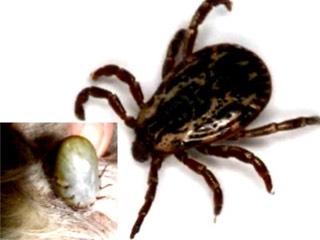
We have all heard that ticks can carry Lyme disease, but In fact, some can emit as many as four or five pathogens, and cause infections in humans and pets.
If a large number of ticks infest a pet, they can suck so much blood that your pet can become anemic. Fortunately, the preventative medicines that can be applied are very effective but a walk in the countryside can still attract those nasty bloodsuckers to our pets.
It is always a good idea to check your dogs for ticks and foxtails after walking in brush or long grasses, by running your hands through their coats and down their legs.
Foxtails are nasty when they embed in your dogs' skin or find their way into your dogs nooks and crannies. These barbed seeds from dried grasses and weeds can be easily inhaled by dogs. They can lodge between toes and in ears, eyes, nostrils, mouth and throat, and can even travel through orifices deeper into body, causing infections and abscesses. Check your dog thoroughly after hiking for foxtails, ticks, etc.
Tick Removal Myths
An internet search for 'tick removal' will reveal a host of wild and wacky folk remedies on how to remove ticks, including use vaseline, burn them off, freeze them off, nail varnish. And all of them won't work — and have the potential to further hurt your pet.
Your vet will tell you that they have never seen a tick "back out" by using these methods. Their head remains embedded in the animal’s skin.” And why would we want to get a flame near our pets. Dogs have hair and hair is very flammable!
The Best Way to Remove a Tick
Put on rubber gloves (if you have them handy) so you’ll never have direct contact with the tick or your pet’s bite area. Ticks can carry infective agents that may enter your bloodstream through breaks in your skin or through mucous membranes (if you touch your eyes, nostrils or mouth).
Treat the bite area with rubbing alcohol and, using a pair of tweezers, grasp the tick as close to the animal’s skin as possible. Pull straight upwards with steady, even pressure. Place the tick in a jar containing rubbing alcohol.
Do not twist or jerk the tick! This may leave the mouth-parts embedded in your pet, or cause the tick to regurgitate infective fluids.
Do not squeeze or crush the body of the tick, because its fluids (saliva and gut contents) may contain infective organisms.
Disinfect the bite site and wash your hands with soap and water. Sterilize your tweezers with alcohol or by carefully running them over a flame.
Disposing of the ticks. The best option is a screw-top jar containing some rubbing alcohol.
Another myth commonly found on wikihow and ehow types of sites is that you should kill the removed ticks by burning them. You should never do this. The tick is actually toxic, when it pops, it can let off a toxic fume that can be harmful to pets and infants.
Throwing a tick in the trash or flushing it down the toilet will not kill it, and it’s actually best to hold on to it for awhile for veterinary testing in case your pet falls ill from the bite.
